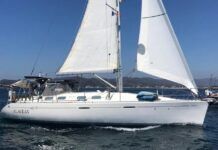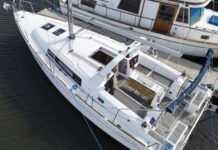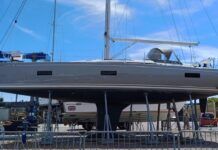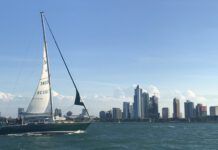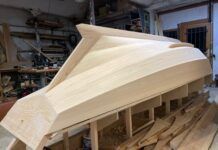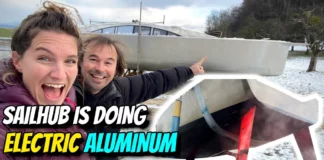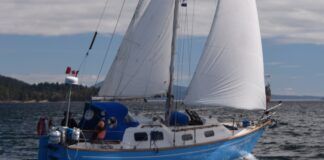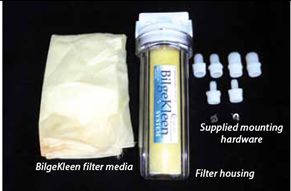
Photo by Frank Lanier
291
There are two primary reasons why U.S. boat owners are required by law to display the familiar “Discharge of Oil Prohibited” placards aboard. For one, it serves as a reminder that we all must do our part to help protect the environment. Secondly, it helps enforcement officials because those carrying the placard can’t plead ignorance of the Federal Water Pollution Control Act.
Any oil that finds its way into a boat’s bilge has the potential to be pumped overboard, where it can cause environmental harm and generate hefty fines. The best way to avoid all this, of course, is to prevent oil from reaching the bilge in the first place (i.e. fixing chronic engine leaks, exercising care during oil changes, etc.); however, accidental leaks can happen to even the most careful among us. As an added line of defense against oil that makes its way past drip pads and oil pans, sailors can install a bilge pump discharge filter such as Centek Industries’ BilgeKleen System, which we recently checked out.
The BilgeKleen System removes oil, gas, diesel fuel, and other hydrocarbon pollutants from bilge water before it’s discharged overboard. According to Centek, BilgeKleen removes 99.9% of the hydrocarbon pollutants with no reduction in pump output.
Available in a variety of sizes and flow rates, each BilgeKleen kit contains a replaceable hydrocarbon removal cartridge, hose fittings, and a clear plastic filter housing, which is mounted between the bilge pump and discharge through-hull fitting (similar to a reverse sea strainer). The kit also contains a SmartPad, which is placed in the bilge sump area to absorb oil, diesel, and gas. Used cartridges and SmartPads should be disposed of in the same way as normal oily waste (like oily rags or bilge pads).
What We Tested
We evaluated Centek’s CTK-8-BK-1 kit, a 10-inch filter system with a maximum flow rate of 25 gallons per minute. The kit came with the filter, the housing with mount ¾-inch NPT hose barb fittings (for ½-, ¾-, and 1-inch hose) and a 14- by 24-inch Smartpad.
The filter canister and mounting system are robustly constructed, well designed, and simple to install. The kit we reviewed retails for less than $100, and replacement filters cost about $40.
How We Tested
Testers’ primary focus was to verify the manufacturer’s claim that the unit does not restrict bilge pump flow rates. We assumed that as the filter becomes saturated with oil and other contaminates, output rates would also decrease, which could be a helpful reminder that the filter cartridge needs replacing. However, Centek representatives explained that flow rates would not be affected even then, and said that users will know it’s time to change the filter when they see an oily sheen on the water while pumping the bilge, indicating oil is making its way past the filter.
We paired the CTK- 8-BK-1 unit with a Shurflo bilge pump (1,000 gallons per hour) powered by a CSI Speco regulated power supply at a constant 13.8 volts. Testers timed how long it took the pump to fill a container of known quantity over three separate runs and averaged them to determine the pump’s flow rate. We then installed the Centek filter, conducted a few test runs to verify proper installation, and then repeated our flow-rate test (over three separate runs) and compared the results.
Ample proof exists that the BilgeKleen filtration technology works, but we conducted a simple test to confirm this. We added a half-quart of motor oil to 8 gallons of water and ran it through the filter.
Results
Using the pump sans filter, it took an average of 70 seconds for the bilge pump to fill a 16-gallon container. That doubled to 140 seconds once the BilgeKleen filter was installed in the pump line, meaning that in our particular test setup, the filter decreased pump output by roughly half. That doesn’t mean the filter installation will decrease pump output by that amount in every installation (which can vary greatly); however, it does show that contrary to the maker’s claims, some flow reduction can be expected.
The BilgeKleen filtered out all of the motor oil during our test. There was no oily sheen or other evidence of oil in the output water.
Bottom Line
Some pump output reduction is the cost of installing a filter in a system, be it bilge pumps, engine fuel, or the freshwater system. Whether you can live with that reduction depends on your bilge pump installation. We do not recommend installing a filter on any high-volume emergency bilge pump. A bilge filter is better suited for dual-pump installations, where a smaller pump is used to handle niggling leaks or rain.
If you do install a bilge filter, we recommend verifying how much pump output would be lost, and determining whether you need to upgrade to a larger pump to make up for the loss.
For installations that are suited for including a bilge filter, the BilgeKleen is a convenient and effective tool for ensuring no errant oil makes its way into the marine environment. For the rest, however, we recommend using pads and sponges for absorbing accidental spills. (For more on these, check out our March 2002 test of bilge absorbers.)





